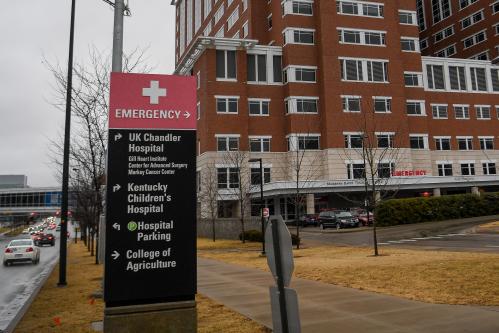What’s the latest in health policy research? The Essential Scan, produced by the USC-Brookings Schaeffer Initiative for Health Policy, aims to help keep you informed on the latest research and what it means for policymakers. If you’d like to receive the biweekly Essential Scan by email, you can sign up here.
Drug Innovation in the Last Decade Increased Productivity by 4.8 Million Work Days, Resulting in $221 Billion in Annual Wages
Study by: Alice J. Chen and Dana P. Goldman
Although productivity losses resulting from poor health create significant drag on the US economy, increases to labor productivity are not traditionally measured when evaluating the costs and benefits of new health technologies. A new study systematically analyzes the relationship between new drug treatments and labor productivity across several disease groups. The researchers examined more than 5000 clinical trials in a 15-year period, finding only 115 (2 percent) evaluated treatment effects on labor productivity. Of the studies with data, they found the largest gains were among infectious diseases (average 42.6 percent gain) and skin diseases (average 82.4 percent gain). Over time, new treatments generated a 30 percent increase in work productivity on average, and subsequent innovations maintained this level of improvement. The authors note that labor sector benefits should be taken into account when assessing the costs and benefits of drug innovation. Full study here.
Fear of Deportation Keeps Eligible Hispanics from Enrolling in Safety-Net Programs
Study by: Marcella Alsan and Crystal Yang
Despite their proven ability to relieve some of the most urgent financial pressures associated with poverty in America, many US citizens eligible for safety-net programs like Supplemental Nutrition Assistance Program (SNAP), Medicaid, and Medicare fail to enroll. While barriers like transaction costs, lack of information, and social stigma make full enrollment in these programs unlikely, these factors do not fully explain why there is a sizable gap between the enrollment rates of Hispanics and the enrollment rates of African-Americans and non-Hispanic whites. By combining micro-data on immigrants detained under the Secure Communities (SC) program from 2008-2013 with data on take-up rates for SNAP and ACA signups, the authors show that fear of possibly revealing individuals in their social or familial network living in the country illegally has kept many eligible citizens from enrolling in safety-net programs. The authors find the activation of SC protocols within a community decreased the Hispanic take-up rate for SNAP benefits in that community by 22 to 34 percent and also lowered the number of Hispanics signing up for the ACA by 22 percent. Foregoing these benefits means that some Hispanic citizens may have to go without basic necessities like food or medical care, which could have long-term adverse effects on the health and financial wellbeing of vulnerable members of Hispanic communities. Full study here.
Patients Treated at Academic Medical Centers Had Lower 30-Day Mortality Rates, Regardless of Patient Severity
Study by: Laura Burke, Dhruv Khullar, E. John Orav, Jie Zheng, Austin Frakt, and Ashish K. Jha
In an effort to cut costs, some policymakers have suggested reserving academic medical centers (AMCs) solely for the treatment of patients with complex or difficult-to-treat conditions. In order to determine which types of patients were most likely to benefit from care at an AMC, a new study compared thirty-day mortality rates for Medicare beneficiaries following hospitalization in both AMCs and non-teaching hospitals. The study found that treatment at an AMC was associated with lower thirty-day mortality rates, compared to treatment at non-teaching hospitals across the spectrum of patient severity for common medical conditions. Similar results were found for surgical procedures (aside from outcomes for low-severity patients which were no different across hospital type). Low-severity patients seemed to benefit the most from AMC care, with 17 percent lower odds of thirty-day mortality when treated at an AMC for a common medical condition as compared to 7 percent lower odds for high-severity patients and 13 percent lower odds for medium-severity patients. Variations in hospital technology accounted for some of these differences, but not all of them. The authors conclude that the better outcomes at AMCs apply to all patients treated — not only the sickest — and suggest that policymakers come up with a different approach to identify patients unlikely to benefit from AMC care. Full study here.
A Review of the Economic Literature of the Pharmaceutical Industry
Study by: Darius N. Lakdawalla
A new literature review summarizes and critically assesses the research on decision problems faced by pharmaceutical firms, with particular emphasis on their relationship and implications for public policy. The researcher focuses on three important decision areas faced by pharmaceutical firms: research and development, pricing, and marketing. Within R&D, the majority of studies analyzed provided evidence suggesting that raising reimbursements for pharmaceuticals stimulates innovation, though economists have not come to a clear answer as to whether pharmaceutical innovation is too high or too low and thus what measures policymakers should take given the associated risks of either under- or over- investing. When assessing pricing strategies, making new, effective drugs accessible to consumers is critical to a firm’s strategy. The literature gives definitive evidence that providing health insurance makes drugs more affordable to consumers, and thus increases access and use. In terms of paying for drugs, the researcher notes, “the model of quantity-based pricing appears creaky and out of date, but regulatory barriers in the US market stand in the way of rapid innovation in pricing.” Finally, public policy surrounding pharmaceutical marketing is strongly debated. Analysis of the benefits and costs of marketing must take into account whether marketing moves society towards both efficient levels of utilization and efficient levels of innovation. The dynamic and complex nature of both of how marketing impacts use (and access) and thereby influences future innovation leads the author to conclude that much remains unknown about the optimal configuration of policies and regulations towards advertising. The author notes that though major gaps and challenges remain in the research, economists also need to contend with the challenge of convincing non-economists, who remain skeptical about the relative importance of economic incentives, especially as we grapple with major policy challenges of pharmaceuticals. Full study here.












Commentary
The essential scan: Top findings in health policy research
June 25, 2018